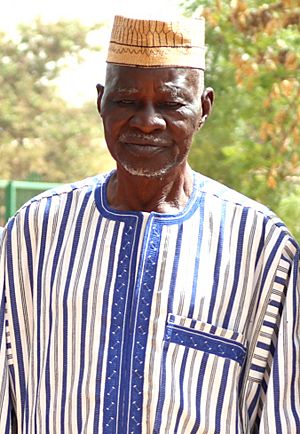Yacouba Sawadogo facts for kids
Quick facts for kids
Yacouba Sawadogo
|
|
|---|---|

Sawadogo in 2019
|
|
| Born |
Yacouba Sawadogo
1946 Gourga, French West Africa (today in Yatenga Province, Burkina Faso)
|
| Died | 3 December 2023 (aged 76–77) Ouahigouya, Burkina Faso
|
| Occupation |
|
| Years active | 1970s–2023 |
| Movement | Zaï |
| Awards |
|
Yacouba Sawadogo (1946 – 3 December 2023) was a farmer and expert in land management from Burkina Faso. He became famous for successfully using an old farming method called zaï to bring life back to land damaged by desertification and dry weather. These methods are part of bigger ideas like agroforestry and farmer-managed natural regeneration.
A movie about his life, The Man Who Stopped the Desert, came out in 2010. It was first shown in the UK.
Sawadogo spoke the Mossi language. He received important awards for his work, including the Right Livelihood Award in 2018 and the Champions of the Earth award in 2020.
Yacouba Sawadogo passed away on December 3, 2023, when he was 77 years old.
Contents
Why the Land Needed Help
The northern part of Burkina Faso is in the Sahel Belt. This is a dry area between the huge Sahara Desert and the green tropical savannas. This region often has long periods of dry weather, called droughts. A very serious drought happened from 1972 to 1984. It caused big problems for many people.
One major effect of the drought was that the land turned into desert. This is called desertification. Other things like too many animals eating the grass, poor farming methods, and too many people also made the problem worse. More and more land became barren, especially on hillsides, because it was hard to farm there. When land is not farmed, it can easily be washed away by rain or become very hard. This also made the underground water levels drop by about one meter each year in the 1980s.
Bringing Life Back to the Soil
In the 1970s, Yacouba Sawadogo and another local farmer, Mathieu Ouédraogo, started trying out ways to fix the damaged soil. They used simple, traditional methods from their region. These methods were called cordons pierreux and zaï holes. Both Sawadogo and Ouédraogo worked hard to teach these methods to other farmers in the area.
Cordons Pierreux: Stone Lines
Cordons pierreux means "stony cordons" in French. They are thin lines of small, fist-sized stones laid across fields. Their job is to catch things. When it rains, water washes soil across the field. The stones slow down the water and make it collect against the lines. This gives the water more time to soak into the ground.
The soil that collects against the stones also creates a good spot for local plant seeds to grow. These new plants help slow the water even more. Their roots also break up the hard soil, making it easier for more water to soak in.
Zaï Holes: Special Pits
Zaï holes are a different way to catch water. They are small holes dug in the soil. Traditionally, people used them a little bit to help barren land. Sawadogo had a new idea: he filled the holes with animal manure and other natural waste. This gave the plants lots of food to grow. The manure also attracted termites, and their tunnels helped break up the soil even more. He also made the holes a bit bigger than they used to be.
Zaï holes have been used to grow trees, as well as crops like sorghum and millet. From the mid-1980s to 2009, using zaï holes helped the underground water levels rise by about 5 meters on average. In some places, the water even rose by as much as 17 meters!
Sharing the Knowledge
To help more people learn about these methods, especially zaï holes, Sawadogo held "Market Days" twice a year at his farm in Gourga village. People from over a hundred villages came to these events. They shared different kinds of seeds, exchanged farming tips, and learned from each other.
His work was also supported by a Dutch scientist named Chris Reij and an organization called OXFAM UK.
Working with the Government
Over more than 20 years, Yacouba Sawadogo's work with zaï holes helped him create a large forest area. This forest was about 62 acres in size. This led to some challenges with the government about who owned the land. Later, the government took steps to protect the area.
The forest can be clearly seen from space using satellite images. It is located east of the hospital and is called Bangr-Raaga in the Mossi language, which means Forest of Wisdom. Later, the nearby city of Ouahigouya took over some of this land. This was part of a government plan to increase city money. Because of this, Sawadogo and his family members were only allowed to keep a very small part of the land, and they did not get any other payment.
In 2008, Sawadogo tried to raise money to buy back his land. The next year, the land was valued at a much higher price because of all his hard work making it fertile.
By 2012, people started building close to the edge of his forest. In 2019, the first buildings appeared inside the forest itself. The authorities said they were working on a plan to protect the land as a special city heritage site.
Finally, a protective fence was built around the entire forest. It was officially opened on June 18, 2021, with Burkina Faso's Minister of Environment present.
See also
 In Spanish: Yacouba Sawadogo para niños
In Spanish: Yacouba Sawadogo para niños
- 2010 Sahel famine
- Permaculture

